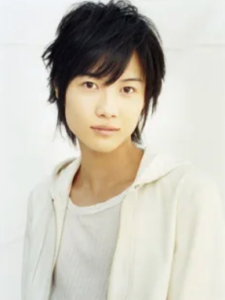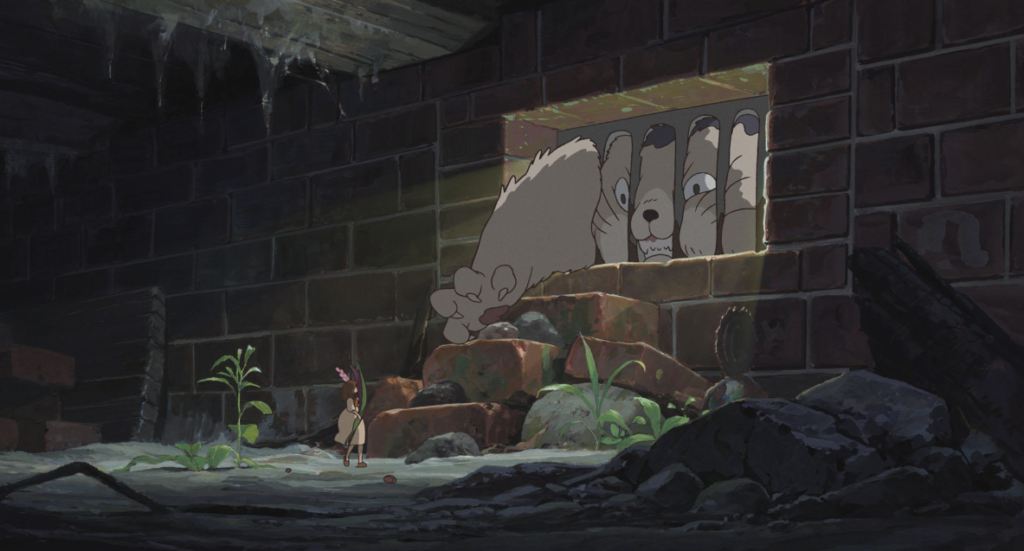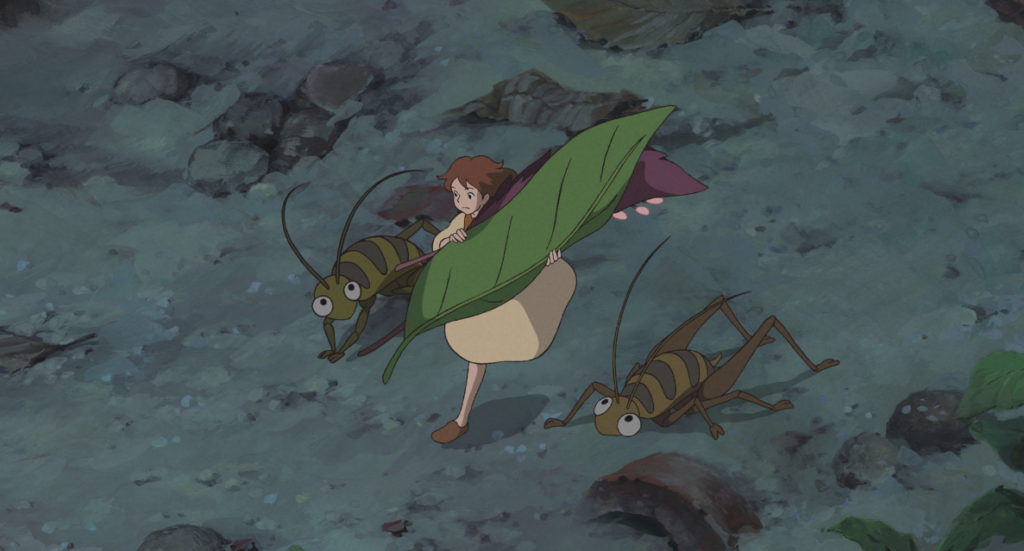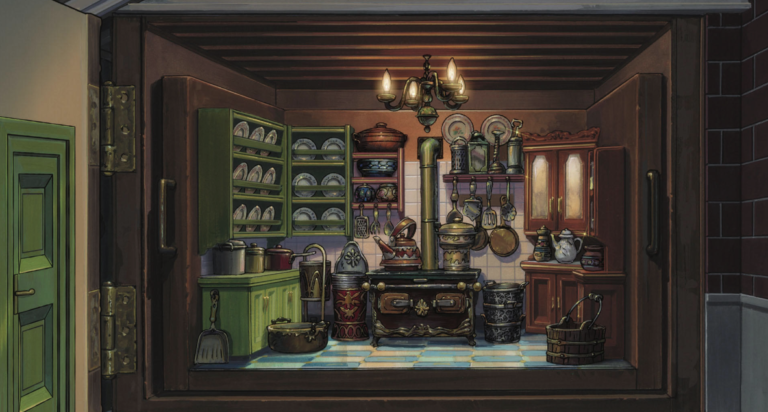
Hiromasa Yonebayashi
I Thought I Couldn’t Be a Director
Interviewer: How did you come to direct “Arrietty”?
“When in the fall of 2008, Mr. Suzuki called me saying, ‘Can you come over?’, I found a prominent group of members, including President Hoshino, Mr. Miyazaki, and Mr. Suzuki, seated when I arrived. As a mere animator, I was anxious about why I was called. They asked, ‘Would you like to direct?’ Internally, I was like, ‘You must be kidding.’ I had no experience in directing and had never drawn storyboards. I thought it was impossible.”
Interviewer: It’s surprising to suddenly be asked to direct a theatrical release.
“Initially, I thought a director should have something they want to convey to others, so I said, ‘I don’t have any particular philosophy or claim, so I can’t do it.’ But both Mr. Miyazaki and Mr. Suzuki assured me, ‘That’s all in this book, so it’s okay.'”
Interviewer: The book you’re referring to is “The Borrowers,” right?
“Yes. I found the novel interesting and captivating, but at that time, I was conducting entrance interviews for Nishi (West) Ghibli (an animator training institute in Aichi Prefecture), so my mind was occupied with that. I took my time reading the novel. However, Mr. Miyazaki and Mr. Suzuki kept coming over alternately, asking, ‘How far have you read?’ – ‘You’re slow! Read faster!’ (laughs). After I finished reading, I was called to Mr. Suzuki’s room again, thinking, ‘Do I have to do this?’ I casually thought that if they found me unfit during the process, they’d surely let me go, so I decided to accept the role for now.”
Interviewer: There was a strong intention from Mr. Miyazaki and Mr. Suzuki to appoint you as a director. How far along was the project when you took on the role?
“Obviously, ‘The Borrowers’ was the source material. The only decisions made were to set the stage in modern-day Japan and finalize the last scene.”
Interviewer: Was the title “The Secret World of Arrietty” already decided?
“It was almost decided. Mr. Miyazaki suggested ‘Little Arrietty,’ but Mr. Suzuki felt it would be better to include the word ‘borrowed.’ The term ‘borrowed’ is impactful. If we didn’t use the kanji for ‘borrow’ in the title, it would be hard to visualize when the word ‘borrow’ was spoken in the movie.”
Interviewer: How did the initial preparations proceed?
“The project started with presenting our ideas to the planner, Mr. Miyazaki. But Mr. Miyazaki is strict, so it’s not easy to get approval. This was true for the story plot, and even for Arrietty’s design. We drew several versions of Arrietty and presented them, but he’d always say, ‘This isn’t it.’ As the schedule started getting tighter, I felt we were in danger. When I began to think that Mr. Miyazaki wouldn’t approve of anything I suggested, Arrietty’s design was suddenly finalized.”
Interviewer: Did Mr. Miyazaki give his approval?
“It felt like he finally concluded ‘Well, why not?’. And then things started to open from there.”
From Mr. Miyazaki’s Plan to Mr. Yonebayashi’s Film
Interviewer: What about the story?
“Regarding the story, in the end, based on Mr. Suzuki’s judgment, it was decided that Mr. Miyazaki would write the screenplay. From around January 2009, based on Mr. Miyazaki’s verbal accounts, Ms. Keiko Niwa began compiling the screenplay, marking the start of the screenplay work.”
Interviewer: But, I’ve heard that many of your ideas are incorporated into the story?
“In the process of production, Mr. Miyazaki’s way is for the work to gradually change. The script given at the start was thoroughly written in the first half, but as it moves to the latter half, it’s loosely crafted. That part had to be developed by me during the storyboard stage. But as I progressed with the storyboard, it inevitably deviated slightly from the screenplay. I tried to adjust the direction back to the script, but it was impossible. So, I asked Ms. Niwa to add to the script in a certain way. Therefore, the development in the latter half might differ from what Mr. Miyazaki initially imagined.”
Interviewer: Which specific parts did you ask Ms. Niwa to rewrite?
“It’s the scene in field where Sho and Arrietty argue. As I traced the flow of Arrietty’s emotions, Arrietty in this scene had to be angry. I had her write Arrietty arguing with Sho.”
Interviewer: Sho also fiercely retaliates, saying “You are a dying race”. I’ve heard that this line was added upon your request?
“No, that line was in the script from the beginning. I had the argument intensified. Sho relates to the ‘dying race’ and it’s a reflection of his love for Arrietty, regretting saying such a harsh thing. I felt that this line contained many of Sho’s feelings.”
Interviewer: It seems to capture Sho’s clumsiness.
“It’s a mix of his affection for Arrietty and his own frustrations. Sho is a boy who’s bad at communication, and he unintentionally hurts others or himself in a snap. But after hearing Arrietty’s straightforward words, he begins to express his true feelings. The scene in the flower field is a very important one.”
Interviewer: I see. So, from the story Mr. Miyazaki began, you expanded it according to his intentions.
“Yes. Mr. Miyazaki once said, ‘The beginning of a story is important. If audiences think the story is a lie from the start, they’ll lose interest. The way the introduction, character explanations, and setting introductions are presented must be done very carefully.’ The driving force of the scenes in the first half greatly influences the rest of the story. The goal of the story is set, but if the path to reach it is fixed, it becomes less interesting. So, it’s better to proceed with a rough direction in mind. This is the mindset when crafting the original animation.”
Interviewer: Compared to the original work, what did you think of the script by Mr. Miyazaki and Ms. Niwa?
“In the original, Arrietty is confined under the floor, she must not meet humans, and she must not go outside. For the Borrowers, humans are a great threat, and they must live in fear under the floor. But that had changed. Arrietty freely walks outside, and the Borrowers under the floor live relatively comfortably. They even use gas, electricity, and water. If the setting is modern-day Japan, then even under the floor, they should be living comfortably. That was Mr. Miyazaki’s idea.”

LArrietty’s Hair and Sho’s Sultriness
Interviewer: There are two finished styles for Arrietty: one with her hair down and one where she uses a clip to hold it up. I thought this pattern was effectively utilized in the story.
“The hair clip symbolizes the title ‘The Borrower Arrietty.’ Initially, I wanted the protagonist to wear something borrowed from humans. I thought of using a clothespin, perhaps in her hair. Compared to Arrietty, it could be something like a stationery clip. As for Arrietty’s hairstyle, I imagined her hair to be wavy and not straight. By clipping it, she finally looked like the protagonist.”
Interviewer: So, her borrowing lifestyle and assertive character are expressed through her hairstyle and clip.
“Exactly. It’s like Kiki’s ribbon in ‘Kiki’s Delivery Service.’ It’s a form of self-assertion. Also, there were scenes in the film where only her silhouette had to be recognized, so I thought this would come in handy.”
Interviewer: When Arrietty first appeared, her hair was down.
“That was the scene where Sho seemed to catch a fleeting glimpse of Arrietty in the grass. I wanted to depict her fairy-like there. With her hair down, her appearance being pale, and her being barefoot. For each scene, there’s a desired Arrietty. Thus, two types of appearances were created. It’s interesting to see there is an “attached clip Arrietty” or “removed clip” Arrietty (laughs).”
Interviewer: Every time Arrietty puts up or lets down her hair, her mood changes.
“The flow of the story essentially reflects Arrietty’s emotions. I thought we could use the hairstyle as a prop for this. Moreover, the gesture of tying up her hair can express sensuality.”
Interviewer: In the storyboard, there were noticeable instructions to portray Sho even more sultrily than Arrietty.
“For Sho, a certain level of rawness was deemed necessary. If the movements of the little people are portrayed in an animated manner, human movements should be depicted more realistically. Sho is frail with complex family ties. A delicate and beautiful boy, so some sensuality was absolutely necessary for his realistic portrayal.”
Interviewer: Sho being a beautiful boy played a significant role in the movie. But it seems that the animation director, Ai Kagawa, found him challenging to draw.
“She might say that, but the Sho drawn by Kagawa is sultry. I believe no one else could have portrayed him that way.”
Interviewer: The boy Nona in Studio Ghibli’s short film “The Day I Harvested a Star” feels similar.
“When I was designing the character, it was decided that Kagawa, who was the animation director for ‘The Day I Harvested a Star,’ would join us. Also, the voice actor is [Ryunosuke] Kamiki.”

Interviewer: So, Ryunosuke Kamiki was also the model for Sho?
“That started after the animation work began. Kagawa wanted to observe someone while drawing. By chance, in a drama, Kamiki played a frail boy. There were scenes where he was lying in bed or getting up, so we used them as references for the animation. From there, we got photo books and calendars of Kamiki for the company, and they were put up on walls (laughs).”
Interviewer: Another significant element is the story’s setting. Whose idea was it to set the story around the Nogawa River in Koganei City?
“It was Mr.Miyazaki’s idea. The setting is around Koganei, on top of a cliff by a pathway, with a vast 2,000 tsubo (approximately 6,600 square meters) plot of land. There’s an old mansion, seemingly forgotten in the dense forest, closed off from the outside world. The story begins as the car carrying Sho leaves the ordinary residential area and enters a forest, where it wouldn’t be surprising to find little people.”


The Prowess of Niiya the Cat and the Scene of Farewell
Interviewer: I think the way you portrayed cats, crows, and insects was a highlight.
“I hate bugs (laugh). Even if I draw them realistically, it just feels gross, so I decided to make them look more like characters. And then there’s the relationship with Arrietty. For instance, Kamadouma (a creature’s name) is a friend to Arrietty, so I drew it in a friendly manner. Conversely, even if I anthropomorphize a cockroach, I drew it creepily.”
Interviewer: Both cats and crows were anthropomorphized, weren’t they?
“Yes. Turning them into manga characters allows for more interesting movements. Especially Niiya, the cat, I think it worked out well. At first, it didn’t really get close to Shou, but as the story progressed, they became more like friends. And in the end, Niiya plays a somewhat mystical role in delivering Arrietty’s message.”
Interviewer: Was Niiya’s significant role your idea?
“The script had a similar development. I interpreted that Niiya is a messenger guiding Shou. Without Niiya, Shou and Arrietty might not have had a proper farewell, so it unexpectedly became a crucial role.”
Interviewer: Whether Shou and Arrietty could say goodbye is a significant difference from the original work. In the original, they couldn’t say goodbye, but in the movie, they finally understood each other.
“From the scriptwriting phase, we decided they should say goodbye. The script had them saying goodbye near the house’s arbor. But I wanted a more romantic location. An open landscape would be more visually appealing. If Shou entered another world at the beginning, he would have to leave it at the end. I thought it became a beautiful scene with Shou walking out of the mansion’s forest on his own.”
Interviewer: It was impactful when Arrietty handed over a hair clip.
“It’s one of my favorite scenes. In return, Shou gives her a sugar cube. Shou gives something that disappears, whereas Arrietty gives something that remains.”
Interviewer: You can imagine their subsequent actions.
“Exactly. Every time something happens, Shou looks at the clip and remembers Arrietty. But Arrietty probably ate the sugar long ago and might be living her life normally, (laugh).”

Life Under the Floor and Dollhouse
Interviewer: You described it as a story of communication between people, and the equal relationship between Shou and Arrietty is lovely. They help each other.
“Yes. Shou is frail but active. That’s his strength. I think the reason Arrietty became fond of Shou is because she sensed an honest and strong presence behind his weak and delicate facade. His good looks probably played a part too, (laugh). Shou often uses the word ‘protect,’ which is a very manly term. He not only says it but shows it through his actions, which I find charming.”
Interviewer: But wasn’t it difficult to depict the heart-to-heart interactions between two characters of such different sizes?
“It was challenging. The angles were crucial in this work. From Arrietty’s perspective, Shou is really large. So there were scenes where Shou had to fill the screen, and fitting Arrietty into the same frame was genuinely difficult. I paid attention to their distance as well. Initially, they are far apart. For Shou, Arrietty was a being on the other side of the mosquito net, unreachable. But as the story progresses, they gradually get closer. The narrative is set only in the mansion and the garden, so how to effectively depict this limited space was essential. I thought if I could successfully illustrate the difference between the world as seen by Arrietty and by Shou, it would be interesting.”
Interviewer: In Arrietty’s world, the life under the floor seems very peaceful and enjoyable.
“The little people utilize things borrowed from humans in ingenious ways and live modestly. In contrast, the humans above have a somewhat distant relationship. This contrast is also interesting.”
Interviewer: How did you determine the characterizations of Pod and Homily?
“In the ‘Borrowers’ living beneath the floor, there’s an archetype of ‘family’, something we modern people have lost. That was set by Mr. Miyazaki. A lot of his ideas are also present in the character designs of Pod and Homily. We were able to create variations with the active Arrietty, the nervous but cheerful Homily, and the quiet and calm father, Pod.”
Interviewer: I thought the balance between the three was exquisite.
“But if they’re one-dimensional, the characters won’t have depth. So, I thought about portraying unexpected sides of them. Although Pod appears to be very stable, within the family, he’s the most sensitive. There was a scene where Pod waits for Arrietty as she visits Sho and comes back. I wonder what he was thinking as he waited (laughs).”
Interviewer: He really seems like a father with a daughter (laughs). On the human side, Haru’s character was interesting.
“As we were developing Haru’s character, there was a tendency for her to become increasingly humorous. We were careful to properly express her human complexities.”
Interviewer: Haru tries to catch the little people, but what was her ultimate goal?
“Haru had seen the Borrowers in the past. At that time, there were many gardeners and helpers in the mansion, and even though she told everyone that she had seen them, no one believed her. That frustration stayed with her, and she thought, ‘I’ll prove it with my own hands someday.’ She didn’t want to find the Borrowers to make money or anything like that. She was doing it for her own beliefs.”
Interviewer: How do you view the character of Sadako?
“While drawing the storyboard, it was hard to grasp Sadako’s emotions. Eventually, I realized that Sadako is synonymous with the mansion and the garden she’s been protecting all along. To the narrative, she became a crucial character. Every item in the mansion is filled with her memories, and each has a reason to be there. Perhaps something she used in her childhood is buried somewhere in the garden.”
Interviewer: Another key element is the Dollhouse.
“The Dollhouse appears in the original work, and I liked the setting where it has been handed down through generations in the family, from Arrietty’s great-grandfather to her grandmother, then to her mother, and next, it will be Sho’s. So, the Dollhouse doesn’t actually belong to Sadako. That’s interesting. In the original, it was depicted as a symbol of mass-consumerism, so we designed it luxuriously, packed with items.”
Interviewer: Sho gives the Dollhouse to the Borrowers, doesn’t he?
“The comparison between the modest Borrower home and the bourgeois Dollhouse was a key point in that scene.”
How do you feel after completing your directorial debut?
Interviewer: Could you share your thoughts on finishing your first directorial work?
“Being a director is incredibly tough. From the moment I received the first script, I knew I couldn’t do it alone. Thanks to the talents of animation directors like Kagawa-san and Yamashita-san, art directors like Yoshida-san and Takeshige-san, color designer Mori-san, and photographer Okui-san, I managed to finish. My job was like ‘borrowing’ (laughs). Because we’re a technical group like Studio Ghibli, even as a first-time director, I could bring the work to life.”
Interviewer: Would you like to challenge the directorial role again?
“As we neared the end, I increasingly felt that I’d never want to do this again (laughs). It’s a really demanding job. I was fortunate with the team this time, but who knows about the next. I feel I got the opportunity to direct at a perfect, almost miraculous, timing. So, I can’t think about directing again for now (laughs). However, being an animator and getting to interact with people I wouldn’t otherwise have worked with was also enjoyable.”